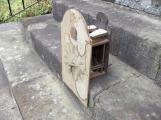1
Heinrich and Regina SteifHeinrich and Regina Steif lived in Germany near the Rhine Basin until sometime after 1749, when they moved to Pennsylvania to start a new life. Life was very difficult in Pennsylvania and land there was scarce, so when Heinrich and Regina heard of a chance to start a better life in New Brunswick, they decided to move again. Many of their children were grown and had their own families by this time, but they also decided to follow their parents and settle in New Brunswick. The Treaty of Utrecht, signed in1713, gave control of the land along the Petitcodiac River and Shepody Bay to the British Government. Following the Expulsion of the French in 1755, the British Government gave control of the lands to companies who would organize settlements and share in the profits if the settlements were successful. One such company was the Pennsylvania Land Company which was set up by John Hughes and Benjamin Franklin, with Anthony Wayne being the chief negotiator. They in partnership with three other land companies established a settlement at what is now Moncton and attracted nine German families from Pennsylvania, including Heinrich and Regina's family, to come and settle on this land. Five of the nine families arrived, aboard a sloop, in Moncton on June 3th, 1766, and began to build houses and establish farms.
When supplies ran low during the next two years, some of the families, including the Steifs, decided to move to a settlement south of Moncton in the area that is now known as Hillsborough. Here it was easier to get supplies, and the land company that controlled this area supported the settlers better.
According to legend, a French man named Belliveau, who had escaped the Expulsion of the Acadians by the British in 1755, found his way to the homes of the new settlers. At first he hid from the settlers, but soon became curious because they spoke a strange language. After realizing that they were not the hated English, Belliveau soon became friends with the Germans. As Belliveau's family had lived in the area for quite some time, he knew how to hunt and fish and passed these valuable skills on to the German families. He taught the women how to tan hides and make footwear. Belliveau did not stay in the area for very long as he feared being captured by the British when he heard cannon fire at Fort Cumberland. So he moved to a piece of land directly across the river from the German settlement and made his home there.
The families were each given one cow by the land company, after they arrived in the area. Over time, the farms grew as the settlers cleared the land. In the 1770 census, Heinrich is reported to have owned "2 oxen, 4 cows, 5 young neat cattle, 8 sheep." Eventually, some of the cattle were driven by foot through the forest to Halifax where they were sold for beef.
Around the time of the American Revolution in 1775, the Steif family who had lived in relative peace, were visited by pirates. The pirates that raided the area were Revolutionary rebels. Some came from the American Colonies, others were individuals from New Brunswick and Nova Scotia who were sympathetic to the American War for Independence. A newspaper article from 1893, describes one such incident when a group of pirates came to the home of Jacob and Catharina Steif:
The residents of the Lower Settlement (as Hillsborough was then most often called) were often raided by a group of robbers. The people had in their own possessions a bull, which was kept in a secluded place. These pirates managed to find out from some person belonging to another settlement where the animal was kept. It was soon captured and converted into food for the band... After this they got together all of the bedding that there was at the house, made themselves a bed on the floor and went to sleep, leaving one of their members on guard. Jacob [Steif] and his wife [Catharina] were left with nothing to sleep on but the bedstead. Katy... said she gathered about her what clothes she wore and tried to get some sleep. Jacob did not try to sleep, and some time during the night he discovered the guard had gone to sleep. He made up his mind to get his axe and dispatch them before they could wake up. Only the earnest entreaties of his wife prevented this resolution being carried out. How many tragedies have been averted by the gentle persuasions of a woman! (Hempel, 2000, 205-206)
One of the first ships built at the settlement was built in 1816 by Jacob Steif at Gray's Island. It was named ‘three brothers' or ‘the brothers' and was used to haul plaster to market in Maine. Heinrich's oldest son, Jacob, was also the first person to open a store in the settlement. He soon ran into problems collecting payment from those to whom he sold on credit, and later went bankrupt.
With the arrival of the Loyalist settlers following the end of the American Revolutionary War in 1781, the economy of the Province began to change from an agricultural based economy to an industrial based economy. As more settlers began to arrive from Ireland and other parts of the British Isles the population of Albert County increased and soon the decedents of Heinrich began to build business to take advantage of this new economic boom. The increased population caused by the arrival of these new immigrants helped to ensure the long term health of the settlement at Hillsborough.
The Steif family name eventually became anglicized and was changed to Steeves in the 1771 Census by DesDeldarnier. It is believed that every Steeves now living in North America is a direct descendant of Heinrich and Regina Steif.

